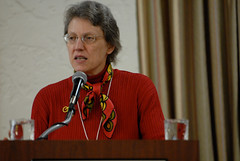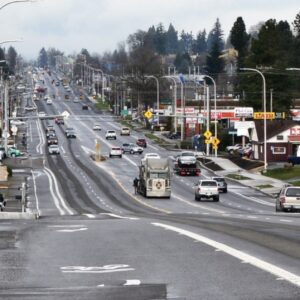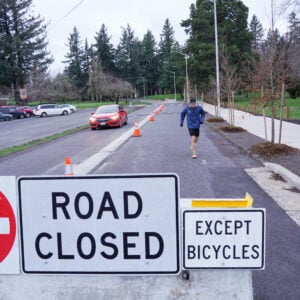The Oregon Transportation Commission is like the Jedi Council when it comes to setting statewide transportation policy. Its members are appointed by the governor and they have tremendous influence over funding, setting direction and priorities, and a host of other decisions that have a direct impact on our state’s transportation system.
With Oregon on an exciting biking trajectory, it occurred to me that all our momentum could be stifled if ODOT (whom the OTC sets policy direction for) is not ready to handle it.
In other words, imagine a funnel with all the projects, programs and great ideas for biking at the top, and a very small hole on the bottom. The hole is ODOT.
“I’m all for a bike path that goes from Klamath Falls to Bly but that’s not where most of the users are. We need to have an integrated look at what we are investing in.”
— Gail Achterman, Chair, Oregon Transportation Commission
Here’s why: ODOT currently has one person two people on their entire 4,500-plus person staff fully devoted to managing biking and walking projects: Sheila Lyons (statewide) and Basil Christopher (Region 1).
That’s a lot of work for for two people and it means that bike projects and other non-motorized initiatives lag. I’ve mentioned this in meetings and privately to many people over the years and now it seems like there’s movement from within ODOT to do something about it.
Turns out that the Chair of the OTC, Gail Achterman, along with Lyons and other ODOT staff, are working to remedy this situation. Several notable recent decisions by the OTC may set a new course for the future of ODOT and active transportation in our state.
I spoke with Achterman about this via phone recently and she detailed three things they’re working on that I’m excited to share.
- Oregon Bike Summit
Friday, June 4th
World Trade Center, Portland
Achterman says the OTC has been working with ODOT staffers to scour every project funding source that can be used for trail and other projects outside of the highway right-of-way (since gas tax revenue is constitutionally dedicated to projects in the state highway right-of-way). The result is what Achterman refers to as an “extraordinarily thought-provoking piece of analysis.”
There’s the 1% “Bicycle Bill” set-aside, federal funds for the Transportation Enhancement and Safe Routes to Schools programs, ODOT bike and pedestrian grant monies, the new Urban Trails Fund, State Parks grants, and a Recreational Trails Program.
Achterman was surprised to learn about all these funding pots. She called them “silo’d funding streams.” “It shows we’ve got dribs and drabs of money across a whole bunch of program areas.”
The funding silos were a revelation to Achterman and she wants to break them down:
“I thought, wait a second here, we ought to be making much better use of these dollars. I had no idea we get federal money that has to be passed to State Parks… I’m all for a bike path that goes from Klamath Falls to Bly but that’s not where most of the users are. We need to have an integrated look at what we are investing in… Let’s figure out what the strategic investment criteria are and what we can get accomplished.”
Achterman shared an example: Imagine improvements made to a school through the Safe Routes program. With a more integrated investment strategy, ODOT would then look to focus other capital investment dollars to build a safe biking and walking path to that school — amplifying the Safe Routes investment and creating a more connected, non-highway system.
In their most recent meeting, the OTC passed a rule that established a new Flexible Funds Advisory Committee to develop criteria to allocate (through a competitive grant program) the state’s $21.1 million in flexible funds available for the remaining biennium.
In a related move, the OTC, under Achterman’s direction, has set aside $2 million to do preliminary engineering (PE) on non-highway projects. One of the glaring issues that came up with the announcement of the federal transportation stimulus dollars is that there were simply not many biking and walking projects that had PE already completed — meaning they weren’t considered “shovel-ready” so they didn’t get funded (meanwhile, ODOT has many highway projects ready to go at a moment’s notice). Achterman hopes boosting the PE dollars for non-highway projects will allow ODOT staff to have more of them ready to go the next time a big funding opportunity comes along. “Hopefully we’ll be in a better position to compete for those dollars.”
Getting back to ODOT staffing levels, Achterman said they have seen a “tremendous appetite” across the state for biking and walking projects. A recent call for projects netted 54 applications in just one week. “You look at that and say, we don’t have the staff to put this together in a comprehensive, smart way.” Achterman said as they work on the budget for 2011-2013, she plans to ask for more staff.
To the non-wonk all this might not seem like such a big deal. But it is. As Chair of the OTC, Achterman is well-versed in the benefits of active transportation. If she can get the requisite level of support (both from the public and the ODOT bureaucracy), Oregon can make exciting new gains in biking and walking.
Achterman is slated to speak about all this and more at the Oregon Bike Summit tomorrow morning. Stay tuned.








Thanks for reading.
BikePortland has served this community with independent community journalism since 2005. We rely on subscriptions from readers like you to survive. Your financial support is vital in keeping this valuable resource alive and well.
Please subscribe today to strengthen and expand our work.
Nice work, Jonathan. Thanks for running interference and keeping us in the loop.
It’s great to see more and more of the transportation officials both at a state and local level starting to look at including bicycle accommodation in with other planning projects, so that the money spent on those projects can be kind of dual-purpose, plus I think we’ll get more bang for our bucks if the projects are thought about ahead of time, rather than trying to retrofit solutions.
Also great to see that there is increasing demand state-wide for bicycle infrastructure, and that the state is taking note of it.
“Achterman said as they work on the budget for 2011-2013, she plans to ask for more staff.”
Good luck with that, considering the state’s gaping budget hole. Heck, even some Republicans are trying to shield schools from the full impact of the cuts (which I can’t say I disagree with), so everything else may be really pinched.
Mark C,
I just edited and added to that sentence. She made a point to tell me she won’t ask for new F/T employees… it will be a matter of transferring existing ODOT staff over to non-highway positions. the ODOT Director’s office is aware of the request and is studying whether or not it is feasible and if/how to carry it out.
Yes, they certainly need to take note of it.
As more and more people cram into our cities, an effective way to basically get more “highway and car” space without building more streets is to get more people onto bikes, or using mass transit.
It just seems (to me, someone who has never worked in transportation) that dollar for dollar, it would be easier to get more people biking by providing tax incentives, safe routes, etc. But the political will needs to be there to do it.
Great policy reporting! I’m in the public sector and I actually understand what some of this stuff means; it’s very hard to convey clearly. You and Gail Achterman have done a great job here, and OMG she knows that criteria is the plural of criterion. \o/
(Gives me a lot of hope for her as a communicator, and, since communication is at the very heart of what she’s trying to do, it gives me a lot of hope for the future of biking in Oregon.)
“ODOT currently has one person on their entire 500-plus person staff devoted to managing the biking and walking projects for the entire state: Sheila Lyons.”
Jonathan, doesn’t ODOT Region 1 (Portland Metro) have a person (Basil Christopher) devoted to bike/ped. concerns?
A well developed Active Transportation System encourages community-centric neighborhoods and helps support a thriving, livable city.
But freight does need to get from here to there.
… doesn’t ODOT Region 1 (Portland Metro) have a person (Basil Christopher) devoted to bike/ped. concerns?
Perhaps but a transportation department that thinks that it is a good idea to place concrete barriers in the middle of a pedestrian transfer area to mass transit with the only distinguishing excuse (every other reason applies to neatly ANY intersection) being “well … it’s a highway that’s why” needs oversight. Oversight that can look at every project that benefits autos and points out how it affects pedestrians and cycles.
In a way that matters and actually has an affect.
Fund these people, not the projects, and we might get somewhere.
People like Achterman who are thinking hard and using ingenuity to find alternative transportation solutions deserve great respect. Thanks for shining a light on the kind of individuals who are making Oregon less car-centric and more walking and biking friendly.
Sounds like ODOT has “extra” money burning a hole in its pocket. Oh, no! don’t save it, lets build bike paths! ya, like that’s an economic job creater. How are working people going to manage in the winter on a frikin’ bike? Portland isn’t it weird, its insane. How does creating worthless bike pathes create a “liveable city”. It doesn’t. Whats a plumber supposed to do, carry their gear on a bike?! of course not, instead they’ll be stuck in traffic because the road was sucked up by bike paths.
As a new public sector employee (working for the City), I have a sense for how this could change over the long term with retirements leading to new positions that become multimodally focused.
A recipe for more rapid change would include the hiring of managers in leadership positions that will direct staff to consider all modes, finding ways to make the rank and file more cognizant of people on bicycles. Change is hard and paradigm shifts like Achterman is seeking at ODOT are more difficult and we’re fortunate to have her leadership guiding the state in this regard.